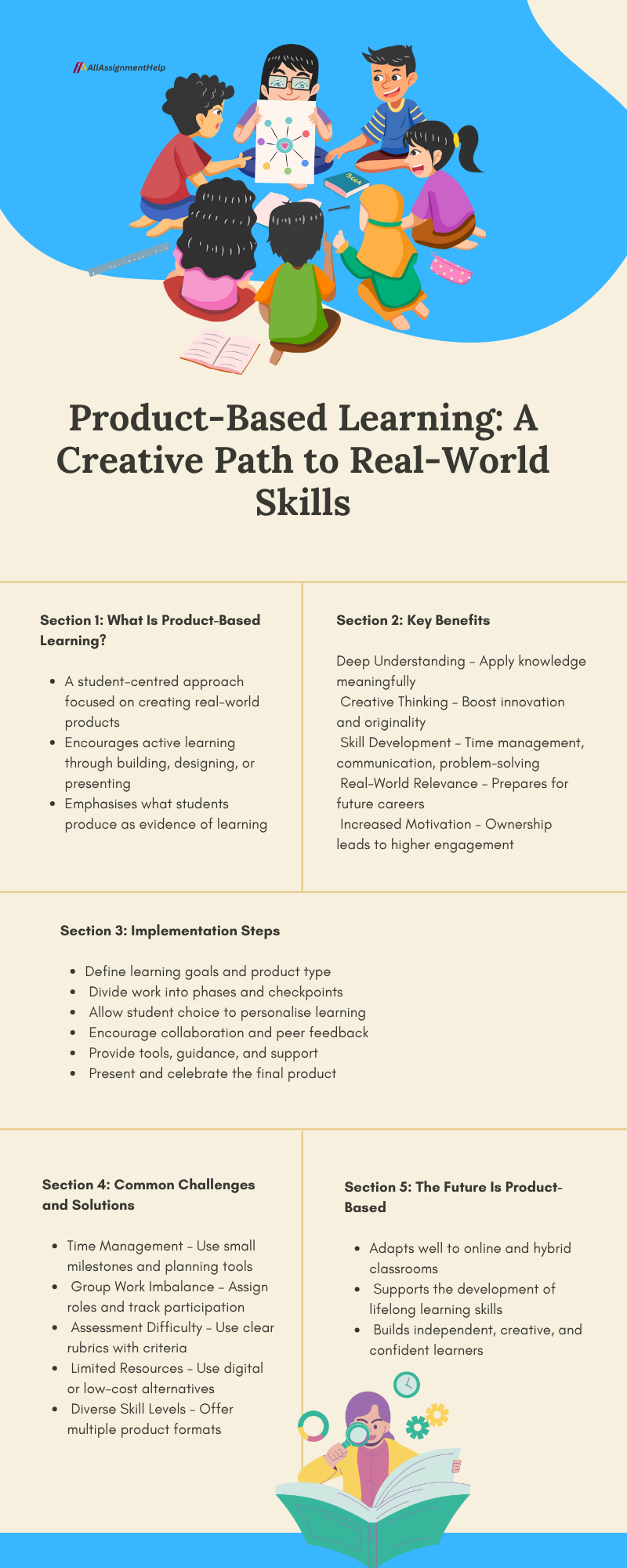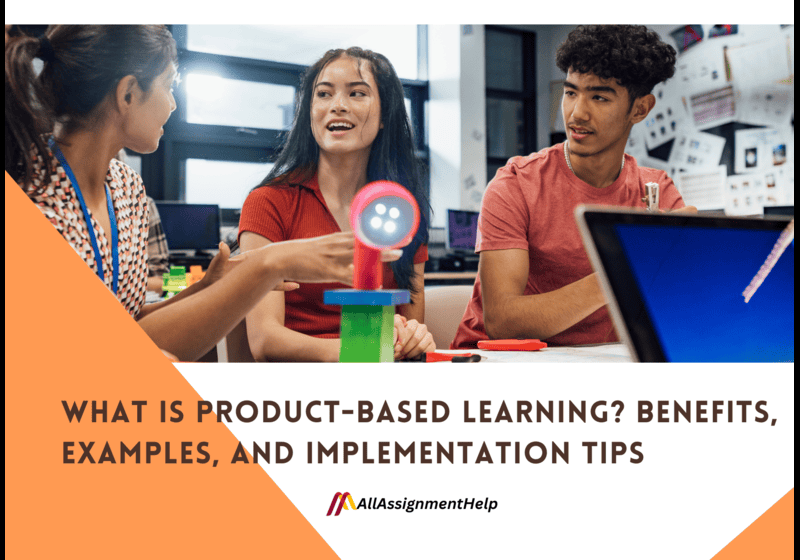Table of Contents
Product-based learning is a teaching method that invites students to produce something physical, like a video, models, reports, or digital content, that reflects an application of their learning in school. Additionally, it is relevant and active. It gives students a chance to explore themes further, as well as skills in problem-solving and presentation. This is a teaching method which is becoming more and more integrated into every sector of education. In this post by All Assignment Help, we are going to dive into what product-based learning is, the benefits for students, examples from real classroom transformation, and provide tips to help educators bring this engagement strategy into their practice.
What Is Product-Based Learning?
Product-Based Learning (PrBL) is a student-centred approach where students produce a tangible product to indicate comprehension of a subject or provide a solution to an authentic problem in the real world. This is different from passive learning, where students are just consuming information. It is about creating more meaningful work, presentations, a video, a blog post, a model, or even an app that reflects the learner’s knowledge, research, and creativity.
Conceptually, you are going to take what you learn from an academic standpoint and have an actual, real-world output at the end. The product is learning-focused, not an additional feature. It provides a fun and real learning experience for students who learn better by doing rather than seeing or reading.
Also read: Project-Based Learning (PBL): Definition, Characteristics, Benefits, and Classroom Ideas
How Product-Based Learning Differs from Project-Based Learning?
Although it is often confused with project-based learning, product-based learning engages students with a different focus. In both situations, learners are carrying out long-term projects and responding to prompts for inquiry. However, product-based learning focuses on the end product as the primary form of evidence of learning. Project-based learning often emphasises the process and discovery over a concrete result.
Additionally, PrBL encourages students to take ownership not only of the content but also of the creation. For example, rather than writing a paper, a renewable energy student might create a prototype of a solar-powered machine. This encourages diversity of theory and focuses on practical application.
Digital tools are available to enable students to design, cr eate, edit, shape, present and share products. Various game-based learning apps, online assignment help portals, and downloadable PDFs are some examples of product-based learning. It is not only providing students with skills for academic achievement in both traditional classrooms and remote learning environments, but also resources to help them navigate real-world challenges with critical, creative, and innovative thought.

What are the Benefits of Product-Based Learning?
The benefits of product-based Learning (PrBL) are immense, and there is more to it than just rote memorisation or multiple-choice test scoring. Students are involved in more meaningful learning, gain real-world skills, and are more self-directed learners by concentrating on real-life product creation. Below are some benefits of product-based learning in the classroom.
Promotes deep and lasting understanding
Students get the chance to apply what they learn with PrBL. They are implicitly interrogating the topic better by developing an artefact, an evidence-based article, or a visual output. It leads to understanding and retaining the knowledge which is absent in the traditional method of learning.
Boosts creativity and innovation
Creativity is free, so it fosters an innovative environment that prepares students for the task of critical thinking and analysis.
Improves collaboration and communication skills
In most cases, product-based learning depends on group work, which involves activity division, idea sharing, and a group output presentation. Working with others fosters vital communication and collaboration development.
Encourages ownership and motivation
Students take ownership of their learning and work, especially when they know others will see or use what they are creating. This incentivises engagement more and improves the quality. Students put time and thought into their work when they know what they are doing will be meaningful and will go into a product.
Prepares students for real-world challenges
If you are often anxious about academic tests, quizzes, etc. and require online class help and guidance to overcome your doubts, like how can I take my online exam with utmost accuracy, then PrBL is something you need.
Product-based tasks are like real-world scenarios compared to standardised tests. Outside of the classroom, they are taught time management, decision-making, research skills and digital literacy, all essential in the real world.
In short, it allows product-based learning to make students into sharers and to create skills that are truly forever.
Also read: Project Management Assignments: Phases and Templates
Examples of Product-Based Learning in Action
These are examples of students studying core subjects through meaningful products they create to showcase their learning. There can be PrBL for all ages, from elementary classrooms to middle and high schools, to college-level courses for any discipline.
Elementary level: Creating a picture book about a science topic
In a fourth-grade science class, students learn about the water cycle. They write and illustrate picture books describing the process in their voice rather than taking a test. This not only reinforces the understanding but also polishes up their writing and storytelling skills.
Middle School: Building board games for history review
In one assignment for middle schoolers learning about ancient civilisations, students create board games, with each question or mini–challenge based on a historical fact. Players progress by answering questions on areas such as Roman governance or Egyptian mythology. This gimmick is a great way to make repeat reviewing enjoyable and informative.
High School: Producing a documentary on local environmental issues
In an environmental science high school course, students investigate a local environmental issue, like air or water pollution and create short documentaries. They become residents, gather data, create proposals, blending science, civic duty, and media production.
College level: Designing a math-based application
University students who are taking applied mathematics are challenged to build a budgeting app that is simplistic in nature and allows them to handle algebra functions and statistical input. It compounds the knowledge by getting them to apply the formulas to a real-world context. The app would also provide mathematics assignment help to students struggling with complex concepts.
These cases have the function of testing how PrBL turns knowledge into learning. By creating a game, prototyping it, etc, students take ownership of their learning. All of these activities are great preparatory tools for a skill in life when we use them right.
How to Implement Product-Based Learning in the Classroom?
Implementing product-based learning (PrBL) in class might sound intimidating initially. But if approached in a certain way, this could be your best shot at ensuring student engagement and the practice of skills.
Define clear learning objectives and the product.
The product needs to fit in with your curriculum objectives, whether it be a model, report, app, or video. This clarity is what sets the tone for the entire learning process.
Break the process into phases.
Structure is needed for product-based learning, just like any well-managed project. Split it into tractable steps:
- Research and planning
- Drafting or prototyping
- Feedback and revision
- Final presentation
This approach removes the students from an overwhelmed headspace and teaches them about fundamental concepts of task ordering. Help your students have better control over time and resources by using simple organising tools such as timetables, task sheets and planners.
Offer choice and personalisation
Ownership of work means better work performance. If it makes sense, let them pick topics or the form of their product. The freedom encourages creativity, and they also take ownership of the project; it adds more relevance to the learning.
Incorporate collaboration and peer feedback.
Support students working as a team or in small groups. Developing products collaboratively teaches conflict resolution, business teamwork, accountability and more. A peer review process at various points also bolsters critical thinking and exposes students to seeing their work through new lenses.
Provide continuous guidance and resources.
Support the students with leading questions, feedback, and relevant resources. You can complement it with digital resources, templates, or even hold expert guest sessions. Finally, when students face difficulties managing a multi-subject product, they tend to seek project management assignment help services to form a proper structure around the planning part, particularly in higher education.
Showcase the final product.
Presentation makes it an indispensable section of product-based learning. Allow students to publicly showcase work through in-class showcases, digital portfolios, or school-wide events. Instilling a sense of responsibility, increasing confidence and motivating students to do their best.
Common Challenges of Product-Based Learning and Solutions
While product-based learning (PrBL) reduces the workload of teachers, it is undoubtedly a challenging enterprise. Below are some of the common challenges educators encounter and actionable ideas to tackle them:
Time constraints
- Challenge: A product requires time, and sometimes, it will take more time than a traditional lesson.
- Solution: Divide and conquer the project. Have mini-deadlines along the way and incorporate them with something already in the curriculum.
Uneven participation in group work
- Challenge: Some students will do more work than others.
- Solution: When working in groups, assign individual responsibilities and give each other peer evaluations.
Difficulty in assessment
- Challenge: We all understand creativity differently. Each of us has a different method of gauging creative work.
- Solution: Along with rubrics about the product (research, creativity, effectiveness), make a specific process.
Limited resources and tools
- Challenge: The limited availability of materials/technology for all schools/students.
- Solution: Promote cheaper or online alternatives; collaboration with local communities or online platforms for resource assistance.
Varying skill levels
- Challenge: Your students are always at different levels of readiness and have different amounts of prior knowledge.
- Solution: Differentiated instruction and product choice would be the solution to this.
Such obstacles can be avoided with some level of consideration and adaptability. Moreover, proper support will open product-based learning to all students in the classroom.
Conclusion
In conclusion, product-based learning is a move away from traditional approaches towards a more meaningful, engaging, skill-based educational experience. Getting students to produce real-world things will become ever more critical in bridging the gap between theory and practice. Such learning develops creativity, collaboration, and critical thinking. PrBL can be adapted for any content area and any age group.
Frequently Asked Questions
Question: What is product-based learning in education?
Answer: Product-based learning, in education, refers to learning by digging into issues, challenges, and real-life projects by developing a product in the conceptual domain of a program.
Question: How is product-based learning different from project-based learning?
Answer: Both are a form of learning-by-doing, where in product-based learning, your focus is on the end-product, and in project-based learning, it will be more about how it is done and the journey of inquiry.
Question: Can we adopt product-based learning in online classes?
Answer: The answer is yes, especially in online classes by using digital tools for collaboration, creation, and presentation.
Question: How do we decide what works best with product-based learning?
Answer: PrBL is particularly effective in subjects such as science, math, history, and language arts, especially when combined with creativity and real-life application.
